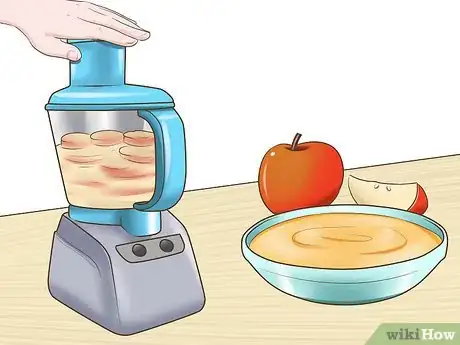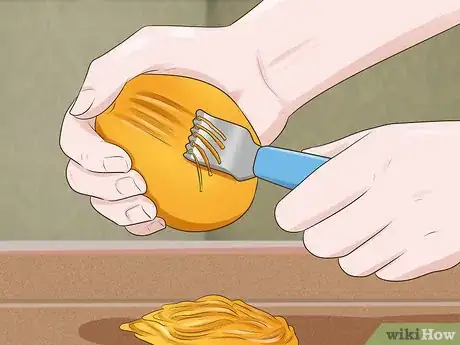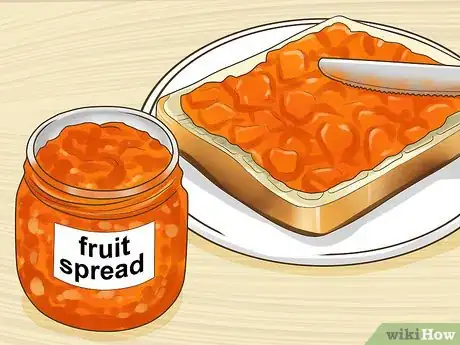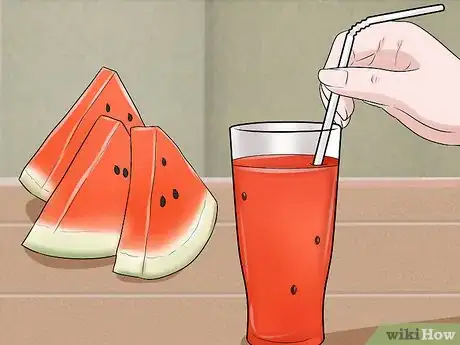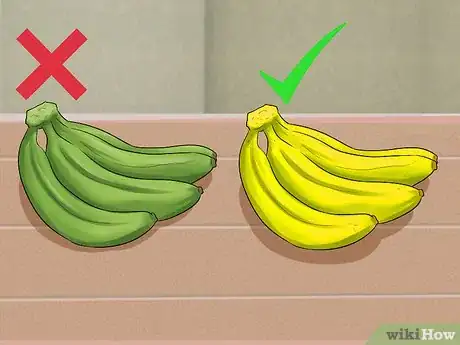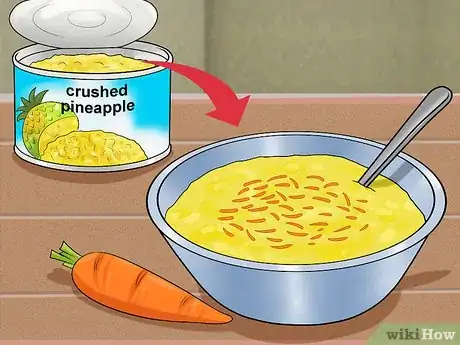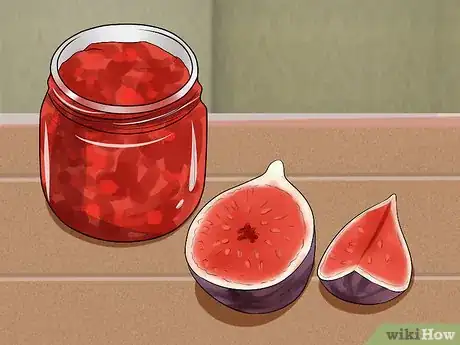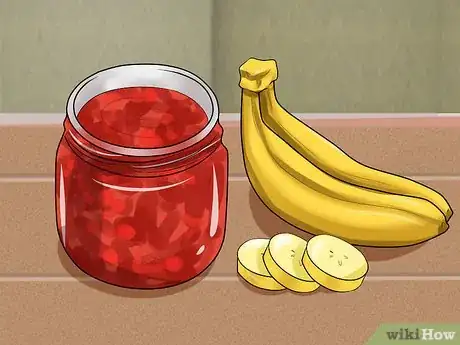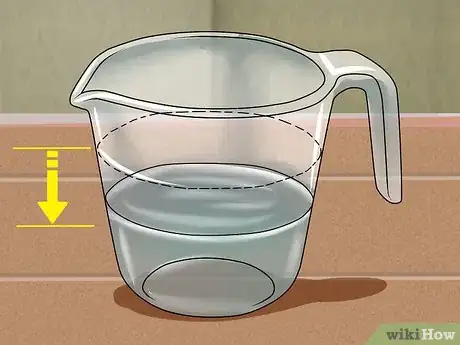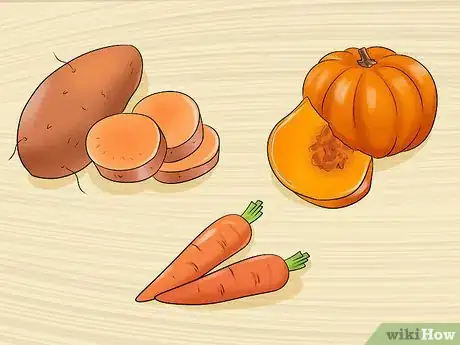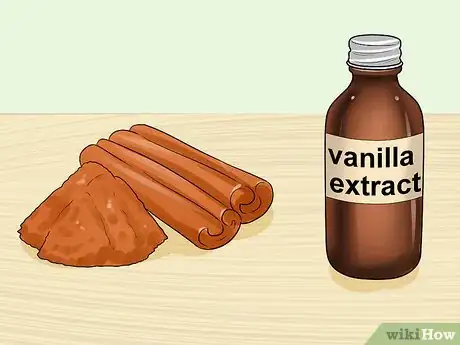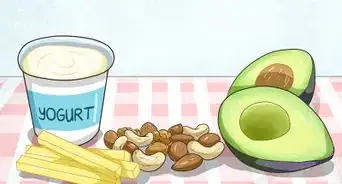This article was co-authored by Claudia Carberry, RD, MS. Claudia Carberry is a Registered Dietitian specializing in kidney transplants and counseling patients for weight loss at the University of Arkansas for Medical Sciences. She is a member of the Arkansas Academy of Nutrition and Dietetics. Claudia received her MS in Nutrition from the University of Tennessee Knoxville in 2010.
There are 8 references cited in this article, which can be found at the bottom of the page.
This article has been viewed 20,894 times.
Regularly consuming refined sugars can contribute to numerous health problems. Fruit also contains sugar, but it provides more nutritional value in the form of vitamins and fiber. You’ll reap the most benefit by occasionally switching in a fruit for a high-calorie sugary treat, but you can also make everyday substitutions to eat more fruit. Try to eat a wide variety of fruits, including tropical or unusual ones. Be prepared to experiment a bit as you make these substitutions. You can even incorporate veggies as another sweetener!
Steps
Using Fruit in a Variety of Forms
-
1Make a fruit puree. Put a banana, figs, papayas, or another fruit into a food processor and pulse until you have a somewhat smooth consistency. You can bake the fruits for a bit beforehand, if you choose. Add this fruit puree into your recipes as a replacement for sugar. If a recipe calls for 1 cup of sugar, you can use ½ cup puree.[1]
-
2Chop the fruit into pieces. Get an assortment of dried fruits and then use a sharp knife to dice them into tiny bits. Add these pieces into a baked recipe or sprinkle them on top of a non-sweet food, such as oatmeal, in place of a few tablespoons of sugar. They will provide a punch of sweetness with more nutrients.[2]Advertisement
-
3Stir in fruit juice. You can press your own juice or you can buy a 100% juice from a store. If you buy from a store, make sure that your product contains no added sweeteners. Be careful when adding juice to a recipe as it can impact the cooking time and consistency of the final product. A ratio of ¾ cup juice for every 1 cup of sugar is usually a good place to start.[3]
- You can also use juice concentrate directly from a can. If you are looking for a more syrupy texture, try boiling the juice until it loses around 30% of its water content.[4]
- If you like to drink fruit juice, limit intake to 4 ounces a day to moderate your sugar intake.
-
4Add in fruit pulp or zest. If you squeeze your own fresh juice, then make sure to save the leftover pulp. Or, get a zester and run a few oranges or limes over it, creating some aromatic shavings. You can think sprinkle the pulp or shaving on top of bland foods, such as yogurts. Adding pulp or shavings into a baked good will also enhance the flavor without requiring any baking or liquid modifications.[5]
-
5Apply a fruit spread. Purchase or make your own jam or jelly. Take a knife and spread it on top of foods that taste good with a bit of additional sugar, such as waffles or whole-grain toast. Make sure to use jelly sparingly, however, as it will still have a high sugar content. To avoid this, you can also simply mash a fruit, such as a ripe banana, until it becomes spreadable.[6]
- To give your jam or jelly an extra kick, mix in a spice, such as vanilla or cinnamon.
-
6Stir fruit into drinks. If you enjoy sweet drinks, but are avoiding them due to their sugar content, then you might use fruit as an alternative sweetener. Slice up watermelon or lemons and place them into your water glass. Mash up some berries and put them in a pitcher, letting this mixture sit overnight.[7]
- Try sparkling water for a refreshing twist, too.
Selecting the Right Fruits
-
1Go with ripe fruits. Fruits that have fully ripened are at their maximum sweetness potential. Their natural sugar content has increased with the ripening process, making them great candidates for a refined sugar replacement. Unripe fruits may be too bitter in taste to provide a seamless substitute.[8]
- To find out how to determine when a fruit is ripe, go online and do a bit of research regarding particular fruits of interest. A banana, for example, loses its green tinting while ripening.
-
2Pick a fruit that complements the recipe. Not all fruits will work well when added to other foods. If you are baking, give the batter a quick taste. Follow this with a quick sampling of your fruit to determine if the flavors mesh together well. Keep experimenting until you find a combination that works.[9]
- In carrot cake, for example, the sweetness of crushed pineapple can bring out the natural sweetness in the carrots even more.
-
3Use dates or figs. Dates and figs are great sugar substitutes, not only due to their naturally sweet flavor, but also because they are very good for you! Each one contains an array of useful minerals, such as iron and calcium.[10] Make a puree by boiling down the figs or dates in a saucepan and then blending them in a food processor until smooth. You can then mix this puree directly into baked recipes or pour it as a sauce over non-sweet foods.
- Figs can be rather dry, so make sure to either boil them or soak them in water prior to blending.
- A date or fig puree can usually be used as a direct one-to-one substitute for sugar in a recipe. Use one cup of puree for every one cup of sugar, for example.[11]
- You can even make a date vinaigrette dressing by pulsing dates, lemon juice, apple cider vinegar, salt, and extra virgin olive oil with a food processor.[12]
-
4Use bananas. This is probably one of the easiest substitute preparations. You can mash a ripe banana until it reaches the consistency that you need. Or, you can mix it in a food processor with a bit of cinnamon or other spices. Usually a banana puree can be used in a baked recipe with a one-to-one ratio.[13]
- When you are making a banana puree, you may need to add a few teaspoons of water to the mixture for consistency.
-
5Go with a more unusual fruit. Don’t be afraid to expand your palette and try new fruit substitutes. Melons are often overlooked, but they can make some of the best additions. The monk fruit, in particular, has gained a great deal of attention lately due to its natural sugar content. Look for monk fruit granule sweeteners in your grocery.[14]
Making Recipe Adjustments
-
1Do a bit of trial and error. Cooking or baking with a fruit replacement is not an exact science. Be prepared to experiment a bit with new flavor and texture combinations. Give yourself extra preparation time to get the fruit ready to add in, too. You might also ask your friends if they have any tried and true recipes using fruit as a sweetener.
-
2Lower the amount of liquid included. In many cases, you will need to adjust the other liquid elements in a recipe to accommodate the addition of fruit. Fruit, even in a dry form, may release liquid into a recipe. The amount that you reduce depends on the final consistency that you desire.[15]
- For example, in a dish using fruit concentrate you will likely need to reduce the addition of other liquids by at least 3 tablespoons.
-
3Monitor the baking time. Similar to the liquid content, if you are baking, then your oven time and temp may need to be adjusted as well. Experiment with adding five minutes and five degrees to see if that changes the final product. Make sure to check any baked good regularly to determine doneness.
-
4Expect some veggies to add a bit of sweetness, too. It is possible to make a food too sweet. When you are deciding how much fruit to use, don’t forget to count in the natural sweetness of the vegetables in your recipe. Sweet potatoes, pumpkin, carrots, beets, and other vegetables all carry an undertone of sweetness. Pair them with a fruit that will draw this out without becoming overwhelming.[16]
- For example, sweet potato and apple often complement one another and go well together in various dishes.
-
5Accentuate sweetness in other ways. To elevate the sweetness of a dish, try adding spices into the mixture. Cinnamon and vanilla, in particular, will bring out the natural sweetness in almost any food. You can also try to place sweet elements in a place where they will be tasted immediately, such as on top of a muffin instead of baked inside of it.[17]
Expert Q&A
-
QuestionWhat can I use to replace sugar?
 Claudia Carberry, RD, MSClaudia Carberry is a Registered Dietitian specializing in kidney transplants and counseling patients for weight loss at the University of Arkansas for Medical Sciences. She is a member of the Arkansas Academy of Nutrition and Dietetics. Claudia received her MS in Nutrition from the University of Tennessee Knoxville in 2010.
Claudia Carberry, RD, MSClaudia Carberry is a Registered Dietitian specializing in kidney transplants and counseling patients for weight loss at the University of Arkansas for Medical Sciences. She is a member of the Arkansas Academy of Nutrition and Dietetics. Claudia received her MS in Nutrition from the University of Tennessee Knoxville in 2010.
Master's Degree, Nutrition, University of Tennessee Knoxville Master's Degree, Nutrition, University of Tennessee KnoxvilleExpert AnswerFruit is a great substitute. Try pureeing fruit or cutting it up into small pieces.
Master's Degree, Nutrition, University of Tennessee KnoxvilleExpert AnswerFruit is a great substitute. Try pureeing fruit or cutting it up into small pieces. -
QuestionCan I substitute a banana for sugar in baking?
 Claudia Carberry, RD, MSClaudia Carberry is a Registered Dietitian specializing in kidney transplants and counseling patients for weight loss at the University of Arkansas for Medical Sciences. She is a member of the Arkansas Academy of Nutrition and Dietetics. Claudia received her MS in Nutrition from the University of Tennessee Knoxville in 2010.
Claudia Carberry, RD, MSClaudia Carberry is a Registered Dietitian specializing in kidney transplants and counseling patients for weight loss at the University of Arkansas for Medical Sciences. She is a member of the Arkansas Academy of Nutrition and Dietetics. Claudia received her MS in Nutrition from the University of Tennessee Knoxville in 2010.
Master's Degree, Nutrition, University of Tennessee Knoxville Master's Degree, Nutrition, University of Tennessee KnoxvilleExpert AnswerYes, you can replace sugar with a banana! You may need to add a few teaspoons of water to the mixture to get the right consistency.
Master's Degree, Nutrition, University of Tennessee KnoxvilleExpert AnswerYes, you can replace sugar with a banana! You may need to add a few teaspoons of water to the mixture to get the right consistency. -
QuestionIs stevia better for you than sugar?
 Claudia Carberry, RD, MSClaudia Carberry is a Registered Dietitian specializing in kidney transplants and counseling patients for weight loss at the University of Arkansas for Medical Sciences. She is a member of the Arkansas Academy of Nutrition and Dietetics. Claudia received her MS in Nutrition from the University of Tennessee Knoxville in 2010.
Claudia Carberry, RD, MSClaudia Carberry is a Registered Dietitian specializing in kidney transplants and counseling patients for weight loss at the University of Arkansas for Medical Sciences. She is a member of the Arkansas Academy of Nutrition and Dietetics. Claudia received her MS in Nutrition from the University of Tennessee Knoxville in 2010.
Master's Degree, Nutrition, University of Tennessee Knoxville Master's Degree, Nutrition, University of Tennessee KnoxvilleExpert AnswerStevia does not contain any calories and does not raise blood sugar. If you are trying to lose weight or control blood sugar, stevia may be a good option.
Master's Degree, Nutrition, University of Tennessee KnoxvilleExpert AnswerStevia does not contain any calories and does not raise blood sugar. If you are trying to lose weight or control blood sugar, stevia may be a good option.
Warnings
- If you are substituting sugar for health reasons, be careful of eating too many extra servings of fruit due to the high sugar content.⧼thumbs_response⧽
- If you count carbohydrates for your diabetes, you will still have to count recipes made with fruit the same as you would recipes made with sugar.⧼thumbs_response⧽
References
- ↑ http://hybridrastamama.com/substituting-sugar-and-natural-sweeteners-with-fruit/
- ↑ http://www.myrealfoodlife.com/part-3-how-to-substitute-sugar/
- ↑ http://dish.allrecipes.com/baking-with-sugar-and-sugar-substitutes/
- ↑ http://hybridrastamama.com/substituting-sugar-and-natural-sweeteners-with-fruit/
- ↑ http://hybridrastamama.com/substituting-sugar-and-natural-sweeteners-with-fruit/
- ↑ https://www.bbcgoodfood.com/howto/guide/sugar-free-baking
- ↑ http://hybridrastamama.com/substituting-sugar-and-natural-sweeteners-with-fruit/
- ↑ https://www.bbcgoodfood.com/howto/guide/sugar-free-baking
- ↑ http://www.bonappetit.com/test-kitchen/ingredients/article/baking-with-sugar-alternatives
- ↑ http://www.organicauthority.com/eco-chic-table/using-fruits-to-replace-sugar-in-your-recipes.html
- ↑ http://www.organicauthority.com/eco-chic-table/using-fruits-to-replace-sugar-in-your-recipes.html
- ↑ https://www.organicspark.com/portfolio/technique-how-i-replace-white-sugar/
- ↑ http://www.organicauthority.com/eco-chic-table/using-fruits-to-replace-sugar-in-your-recipes.html
- ↑ http://www.thekitchn.com/monk-fruit-sweetener-ingredient-spotlight-186887
- ↑ http://dish.allrecipes.com/baking-with-sugar-and-sugar-substitutes/
- ↑ http://hybridrastamama.com/substituting-sugar-and-natural-sweeteners-with-fruit/
- ↑ http://hybridrastamama.com/substituting-sugar-and-natural-sweeteners-with-fruit/
